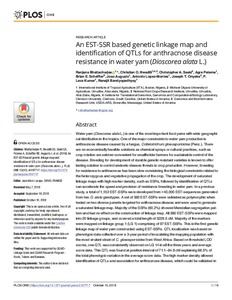| dc.contributor.author | Bhattacharjee, R. |
| dc.contributor.author | Nwadili, C.O. |
| dc.contributor.author | Saski, C.A. |
| dc.contributor.author | Agre, A.P. |
| dc.contributor.author | Scheffle, B.E. |
| dc.contributor.author | Augusto, J. |
| dc.contributor.author | López Montes, A. |
| dc.contributor.author | Onyeka, J.T. |
| dc.contributor.author | Kumar, P.L. |
| dc.contributor.author | Bandyopadhyay, Ranajit |
| dc.date.accessioned | 2019-12-04T11:26:29Z |
| dc.date.available | 2019-12-04T11:26:29Z |
| dc.date.issued | 2018-10-10 |
| dc.identifier.citation | Bhattacharjee, R., Nwadili, C.O., Saski, C.A., Agre, P., Scheffler, B.E., Augusto, J., ... & Bandyopadhyay, R. (2018). An EST-SSR based genetic linkage map and identification of QTLs for anthracnose disease resistance in water yam (Dioscorea alata L.). PLOS ONE, 13(10):318378, 1-16. |
| dc.identifier.issn | 1932-6203 |
| dc.identifier.uri | https://hdl.handle.net/20.500.12478/4623 |
| dc.description | Open Access Journal |
| dc.description.abstract | Water yam (Dioscorea alata L.) is one of the most important food yams with wide geographical distribution in tropics. One of the major constraints to water yam production is anthracnose disease caused by a fungus, Colletotrichum gloesporioides (Penz.). There are no economically feasible solutions as chemical sprays or cultural practices, such as crop rotation are seldom convenient for smallholder farmers for sustainable control of the disease. Breeding for development of durable genetic resistant varieties is known to offer lasting solution to control endemic disease threats to crop production. However, breeding for resistance to anthracnose has been slow considering the biological constraints related to the heterozygous and vegetative propagation of the crop. The development of saturated linkage maps with high marker density, such as SSRs, followed by identification of QTLs can accelerate the speed and precision of resistance breeding in water yam. A total of 380 EST-SSRs were used to generate a saturated linkage map. About 60.19% of SSRs showed Mendelian segregation pattern, however, it had no effect on the construction of linkage map. All 380 EST-SSRs were mapped into 20 linkage groups covering a total length of 2559.66 cM, which agrees with the diploid nature (2n = 2x = 20) of the parents used in the cross. Majority of the markers were mapped on linkage group 1 comprising of 97 EST-SSRs. This is the first genetic linkage map of water yam constructed using EST-SSRs. QTL localization was based on phenotypic data collected over a 3-year period of inoculating the mapping population with the most virulent strain of C. gloeosporoides from West Africa. Using the mean permutation value of LOD scores as threshold value for declaring a putative QTL on all linkage groups, one QTL was consistently observed on linkage group (LG) 14 in all the three years and average score data. This QTL was found at position interval of 71.12 - 84.76 cM explaining 68.94% of the total phenotypic variation in the average score data. The high marker density allowed identification of QTLs and association for anthracnose disease, which could be validated in other mapping populations and used in marker-assisted breeding in D. alata improvement programmes. |
| dc.description.sponsorship | United States Agency for International Development |
| dc.format.extent | 1-16 |
| dc.language.iso | en |
| dc.rights | CC0-1.0 |
| dc.subject | Colletotrichum Gloeosporioides |
| dc.subject | Yams |
| dc.subject | Qtl |
| dc.subject | Water Yam |
| dc.subject | Dioscorea Alata |
| dc.title | An EST-SSR based genetic linkage map and identification of QTLs for anthracnose disease resistance in water yam (Dioscorea alata L.) |
| dc.type | Journal Article |
| dc.description.version | Peer Review |
| cg.contributor.crp | Agriculture for Nutrition and Health |
| cg.contributor.crp | Maize |
| cg.contributor.crp | Grain Legumes |
| cg.contributor.affiliation | International Institute of Tropical Agriculture |
| cg.contributor.affiliation | Clemson University |
| cg.contributor.affiliation | Agricultural Research Service |
| cg.contributor.affiliation | National Root Crops Research Institute, Nigeria |
| cg.coverage.region | Africa |
| cg.coverage.region | West Africa |
| cg.coverage.country | Benin |
| cg.coverage.country | Cote D'Ivoire |
| cg.coverage.country | Ghana |
| cg.coverage.country | Nigeria |
| cg.coverage.country | Togo |
| cg.creator.identifier | Ranjana Bhattacharjee: 0000-0002-5184-5930 |
| cg.creator.identifier | Paterne AGRE: 0000-0003-1231-2530 |
| cg.creator.identifier | Antonio Jose Lopez-Montes: 0000-0001-5801-2475 |
| cg.creator.identifier | P. Lava Kumar: 0000-0003-4388-6510 |
| cg.creator.identifier | Ranajit Bandyopadhyay: 0000-0003-2422-4298 |
| cg.researchtheme | BIOTECH & PLANT BREEDING |
| cg.researchtheme | PLANT PRODUCTION & HEALTH |
| cg.isijournal | ISI Journal |
| cg.authorship.types | CGIAR and developing country institute |
| cg.iitasubject | Plant Breeding |
| cg.iitasubject | Plant Health |
| cg.iitasubject | Plant Production |
| cg.iitasubject | Yam |
| cg.journal | PLOS ONE |
| cg.howpublished | Formally Published |
| cg.accessibilitystatus | Open Access |
| local.dspaceid | 101146 |
| cg.identifier.doi | https://dx.doi.org/10.1371/journal.pone.0197717 |

